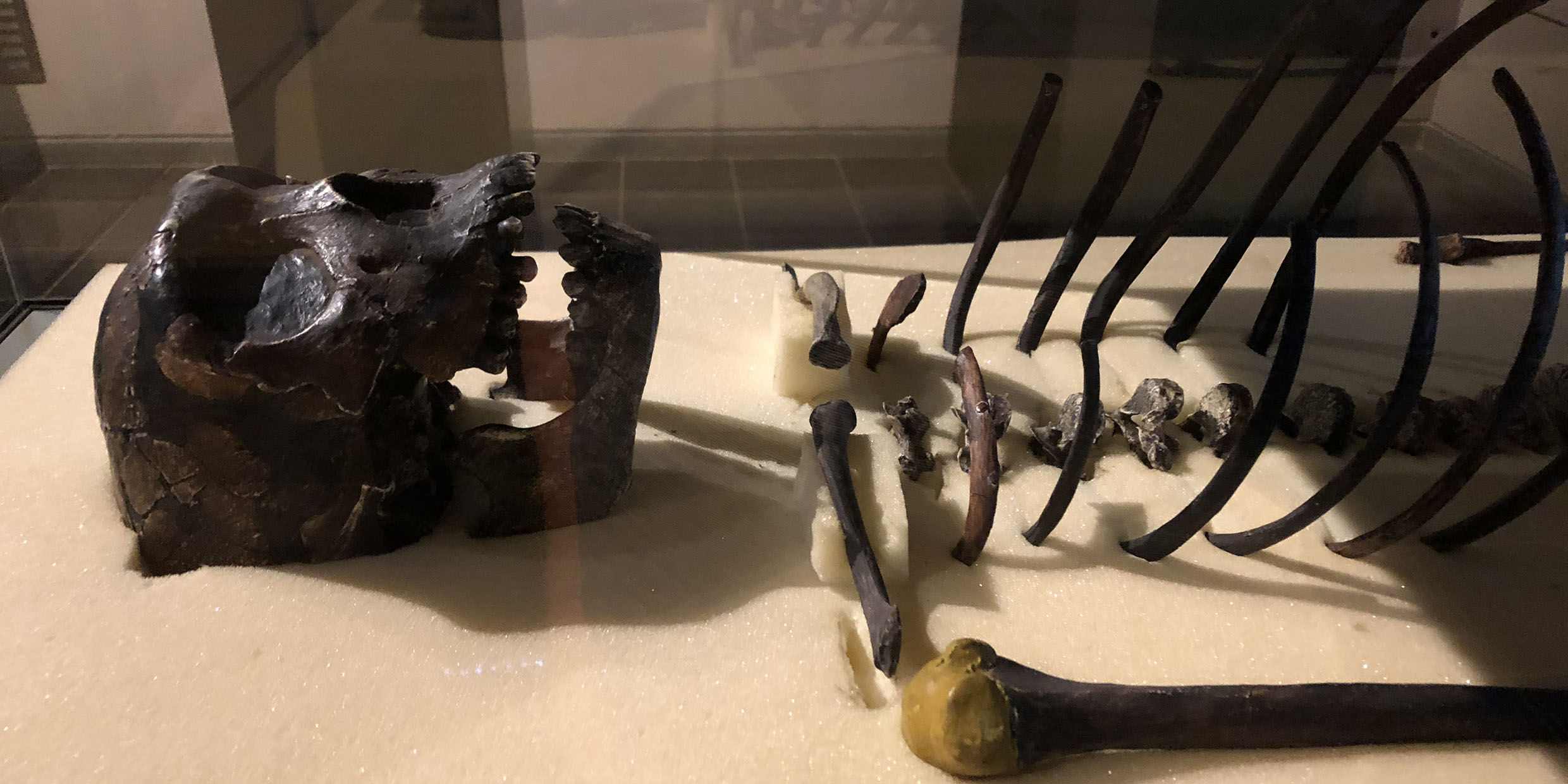Originally published 3 January 1994
I’ve been living with the kid for three weeks. He stands in the corner of my office, dead still, staring blankly. I call him Nari.
I’ve grown quite fond of him. He is 11 or 12 years old, a strapping youth of about 5‑foot‑3. He would have stood over six feet tall had he lived to maturity.
He has been dead for one-and-a-half million years.
Nari is a poster boy. His life-sized image graces a poster supplied by Harvard University Press to advertise a new book, The Nariokotome Homo erectus Skeleton, edited by Alan Walker and Richard Leakey. It is a handsome, haunting poster. Nari’s almost complete skeleton is posed against a black background. The bones glisten with a rich bronze patina.
To my untutored eye, the skeleton looks remarkably modern. The proportions of the body are graceful, almost delicate. I need only close my eyes and the fleshed-out boy steps forward, grinning good-naturedly, hand extended in greeting.
It was because of the poster that I turned to the book. I wanted to know more about Nari, about his life and his death. Not that I expected much. After all, how much is it possible to know about a boy who lived and died more than a million years ago in what is now East Africa?
A surprising amount, it turns out. For one thing, Nari is the most complete early hominid (human ancestor) skeleton ever discovered. For another, his bones are among the most intensely studied fossils of all time. Walker’s and Leakey’s book brings together contributions by experts in paleobiology, geology, anatomy, anthropology, and ecology.
It is a stunning detective story, and a satisfying demonstration of the power of the scientific method to give flesh to the past.
The experts call him the Nariokotome boy, after the dry river bed in northern Kenya near which he was discovered in 1984. His technical designation is KNM-WT 15000, the acquisition number of his skeleton at the Kenya National Museum. But I’ll continue to call him Nari, because that is how I came to know him during the weeks he stood in the corner of my room.
Nari lived in rich grasslands bordering a river that flowed near what is the present basin of Lake Turkana. The river’s seasonal flood left several large swamps that would take most of the year to dry out. The grasslands and swamps were home to many species of plant-eating animals, together with their attendant predators and scavengers. Volcanoes occasionally showered the river valley with blankets of ash.
How did Nari die? His skeleton shows no signs of violence. The only abnormal feature is a pocket of inflammatory gum disease related to the loss of a tooth not long before his death. Before the advent of antibiotics half a century ago, death from septicemia from tooth and gum abscesses was common. Nari may have died from gum infection after the shedding of a milk tooth.
At death, his body either fell into a swamp or was washed into it by a minor flood. For a while it floated face down while decomposing. The body drifted a few meters, was trod upon by hippos, sucked by catfish and chewed by turtles. In time, nearly all of the bones came to rest in a shallow part of the swamp, became embedded in mud, and remained there for a million and a half years until they began to be eroded out of sediments at the side of a small tributary of the Nariokotome River.
In life, Nari was powerfully muscled, yet slender — a runner’s build. He was at the age when he was learning the arts of hunting and gathering from his elders. Like them, he almost certainly prepared his prey for eating with carefully-crafted stone choppers and scrapers. He probably used fire.
All of this marks Nari as a true human ancestor. But there is so much more we want to know, about which the bones are silent. Did he speak? Did he fall in love? Did he grieve for a dead friend? Did he dream?
The authors of The Nariokotome Homo erectus Skeleton struggle valiantly with these questions, most explicitly the first. They measure the bones in every possible way, comparing them with modern skeletons. They examine the shape and size of the brain case, looking for clues to those parts of the brain known to be crucial for speech. They examine the air passageways of the nose and throat. They probe the spinal cord for clues to the central nervous system. Four-hundred pages of graphs, charts, schematics, measurements, and comparisons. In the end, the bones retain their most precious secret: Nari’s inner life.
I look again at the life-sized poster. What was he thinking as he lay at the edge of the swamp, racked by the pain of infection, burning with fever? Did he know that he was going to die? Did he grieve for the life he would not live? Did he cry out at the unfairness of a universe that would take a boy in the prime of his life?
If a skull can be said to have an expression, there seems to be a fierceness to Nari’s face, perhaps even anger. Did he rage, rage against the dying of the light with a fully-human consciousness? Or was he silent, thoughtless, not yet capable of having or of giving expression to thoughts of the terrible and the sublime?
I can’t tell you why, but looking at Nari’s skeleton, I know that he is me, my bone, my blood, my incipient dreams, rooted deep, deep in the evolving mystery of consciousness, long ago and far away.



